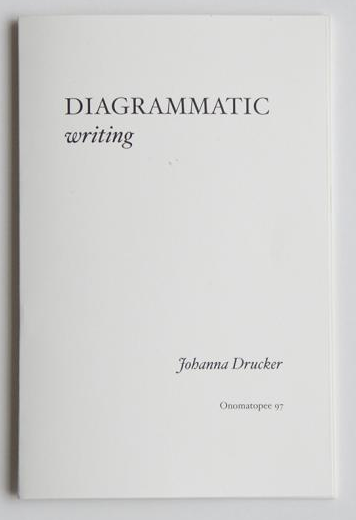Johanna Drucker: Diagrammatic Writing (2013)
Filed under artist publishing | Tags: · book, diagram, gestalt theory, graphic design, text, writing

“This is a book that is as close as possible to being entirely about itself.”
Diagrammatic Writing is a poetic demonstration of the capacity of format to produce meaning. The articulation of the codex, as a space of semantically generative relations, has rarely (if ever) been subject to so highly focused and detailed a study. The text and graphical presentation are fully integrated, co-dependent, and mutually self-reflexive.
This small book work should be of interest to writers, bibliographers, designers, conceptual artists, and anyone interested in the meta-language of diagrammatic thought in graphic form.
Edited, written and designed by Johanna Drucker
Online edition: /ubu editions, Visual Writing series
Printed edition: Onomatopee, Eindhoven; Cabinet Project, 97
Creative Commons BY-NC License
32 pages
via UbuWeb
Commentary: Johanna Drucker (New Formations, 2013), Johanna Drucker (Iowa Review, 2014).
PDF (updated on 2018-12-31)
Comment (0)Kenneth Goldsmith: Uncreative Writing: Managing Language in the Digital Age (2011)
Filed under book | Tags: · appropriation, authorship, conceptual writing, concrete poetry, data, language, literary theory, literature, poetry, technology, text, uncreative writing

“Can techniques traditionally thought to be outside the scope of literature, including word processing, databasing, identity ciphering, and intensive programming, inspire the reinvention of writing? The Internet and the digital environment present writers with new challenges and opportunities to reconceive creativity, authorship, and their relationship to language. Confronted with an unprecedented amount of texts and language, writers have the opportunity to move beyond the creation of new texts and manage, parse, appropriate, and reconstruct those that already exist.
In addition to explaining his concept of uncreative writing, which is also the name of his popular course at the University of Pennsylvania, Goldsmith reads the work of writers who have taken up this challenge. Examining a wide range of texts and techniques, including the use of Google searches to create poetry, the appropriation of courtroom testimony, and the possibility of robo-poetics, Goldsmith joins this recent work to practices that date back to the early twentieth century. Writers and artists such as Walter Benjamin, Gertrude Stein, James Joyce, and Andy Warhol embodied an ethos in which the construction or conception of a text was just as important as the resultant text itself. By extending this tradition into the digital realm, uncreative writing offers new ways of thinking about identity and the making of meaning.”
Publisher Columbia University Press, 2011
ISBN 0231149913, 9780231149914
272 pages
Interviews with author: CUP blog (2011), Mark Allen (The Awl, 2013).
Reviews: Andrea Quaid (American Book Review, 2011), Sam Rowe (Full Stop, 2011), Stephen Burt (London Review of Books, 2012), Amelia Chesley (J Electronic Publishing, 2012), Michael Jauchen (HTMLGiant, c2012), Grant Matthew Jenkins (James Joyce Quarterly, 2012), Andrew McCallum (English in Education, 2013).
Commentary: Special section of American Book Review dedicated to uncreative writing (ed. Doug Nufer, 2011).
HTML (added on 2016-03-01)
EPUB (updated on 2015-10-9)
Bonnie Mak: How the Page Matters (2011)
Filed under book | Tags: · book, codex, e-book, image, library, paratext, print, reading, text, typography

“From handwritten texts to online books, the page has been a standard interface for transmitting knowledge for over two millennia. It is also a dynamic device, readily transformed to suit the needs of contemporary readers. In How the Page Matters, Bonnie Mak explores how changing technology has affected the reception of visual and written information.
Mak examines the fifteenth-century Latin text Controversia de nobilitate in three forms: as a manuscript, a printed work, and a digital edition. Transcending boundaries of time and language, How the Page Matters connects technology with tradition using innovative new media theories. While historicizing contemporary digital culture and asking how on-screen combinations of image and text affect the way conveyed information is understood, Mak’s elegant analysis proves both the timeliness of studying interface design and the persistence of the page as a communication mechanism.”
Publisher University of Toronto Press, 2011
Studies in Book and Print Culture series
ISBN 080209760X, 9780802097606
ix+129 pages
Reviews: Martha W. Driver (Speculum, 2013), Martin G. Eisner (Renaissance Quarterly, 2013), Brett A. Hudson (Papers of the Bibliographical Society of America, 2014), Julie Holcomb (Information & Culture, 2012).
Interview with author: Gretchen E. Henderson (Ploughshares Literary Magazine, 2013).
PDF (scan; updated on 2023-6-5)
PDF (updated on 2020-10-7)

